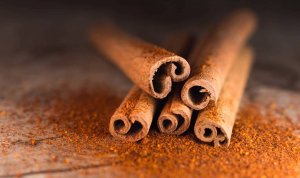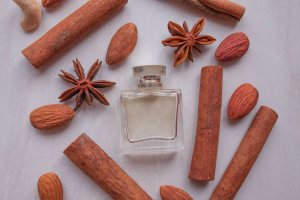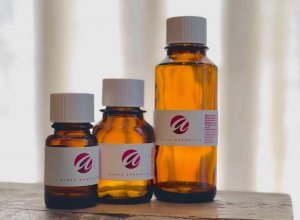In the enchanting realm of perfumery, one scent stands as the epitome of autumnal allure: the fragrance of cinnamon. With its warm and spicy notes, cinnamon captures the essence of fall, evoking cozy moments and nostalgic memories. Discover how this quintessential aroma weaves its aromatic magic in the world of scents.
Cinnamon is a spice that wears many hats; that is, if spices could wear hats.
It has a rich and colorful history and is highly prized for all of its many applications, which range from food to medicine to the fine perfumes formulated by our very own master perfumers at Alpha Aromatics.
The essential oil is obtained from the dried inner bark of several bushy evergreen tree species from the genus Cinnamomum that are known for their oval leaves, thick barks and wild berries.
Today, cinnamon is grown in Asia, the West Indies, and South America. Some of these countries include: Sri Lanka, India, Bangladesh, Myanmar, China, Vietnam, and Indonesia.
The Tedious Process of Harvesting
When the time for the tedious practice of harvesting occurs, the outside of the tree’s bark is peeled off and scraped, exposing the inner layer.
After removal, the pieces are sun-dried for about 24 hours, which causes them to curl into quills.
These are subsequently stuffed with smaller pieces of bark, which stabilizes the outer quill. It is a labor intensive process that at best yields about three pound of quills per day.

The quills are then left to dry for three or four days and sent to a facility where they are graded and priced according to their width, thickness, color and essential oil content.
The resulting brown oil is used in many perfumes, and is coveted for its spicy, delicate fragrance and warm, sugary flavor.
For that reason, it is often ubiquitous within Autumnal or Fall-type fragrances.
The Many Historical Uses Of Cinnamon
In the world of food, cinnamon is used mainly as an aromatic condiment and additive in a wide variety of cuisines, sweet and savory dishes, breakfast cereals, snack foods, bagels, teas, hot chocolate and traditional foods.
It is a popular choice for flavoring curry on the Indian subcontinent, savory chicken and lamb dishes in the Middle East, and chocolate and yams in Mexico.
In the West, it is often found in baked goods like cinnamon rolls and cookies, or with apples and pears in hearty pies, crumbles and cobblers.

Additionally prized for its medicinal values for thousands of years, historians believe that cinnamon dates back at least to 2000 BC to ancient Egypt where it was used for culinary, embalming and medicinal purposes.
Rich in antioxidants and other beneficial compounds, cinnamon has been prized for its medicinal properties for thousands of years.
Chinese records from 2800 BC note the presence of true cinnamon, which was known as kwai. Its name derives from both the Hebrew and Arabic word, amomon, which translates into fragrant spicy plant.
In Roman times, Emperor Nero, as a sign of remorse for murdering his wife, was said to have ordered a year’s supply of cinnamon to be burned in her honor.
Once considered more valuable than gold, cinnamon was highly coveted during the Middle Ages (spanning about a thousand years from the fall of Rome until the 14th century) both as an ingredient for religious rites and as a food flavoring.
The quest for cinnamon and other spices motivated both Christopher Columbus’s voyage to the new world and Vasco da Gama’s exploration of South India and Sri Lanka.
The Portuguese controlled the cinnamon trade for many years afterwards with a cruel and heavy hand until they were overpowered first by the Dutch and then in 1815 by the British.
Cinnamon And Its Use In The World of Perfumery
The inherent powdery sweetness of cinnamon has attracted perfumers down through time, and to this day it is found in the many fragrance formulations we’ve developed over the years for a multitude of products, both in its essential oil form and its synthetic form.
Enticing and cozy, it suggests home and hearth in a way no other spice can.

Warm, woody, vanilla-nuanced and slightly fruity, cinnamon blends well with ambery and woody (chypre) perfumes.
It renders a tender sweetness and flourish of spice to gourmand formulations, and when blended with floral aspects, adds a touch of inviting sensuality.
The Diverse Categories and Species
While many may believe that cinnamon is a one dimensional spice that is associated with autumn flavors and scents, there are diverse types that have been harvested across the centuries, and each has its own distinctions and complexities that sets it apart from others.
There are two main classes of cinnamon; namely, Ceylon and Cassia, and four major species, which are further classified according to their point of origin.
More on each follows below.
1. True Cinnamon aka Ceylon or Mexican (Cinnamonium zeylanicum)
Ceylon cinnamon is very expensive because of its intense and laborious harvesting process, which can only be performed during the early rainy season in Sri Lanka when its delectable aroma is the most concentrated.
The highest quality of Ceylon cinnamon takes four times longer to produce than other varieties. Pieces that are cracked or broken are made into a ground powder.
It is light brown in color and the most preferred category. It is commonly found in the kitchens of Mexico and Europe.
Ceylon cinnamon has a light brown hue and is made of the multiple thin, delicate layers of the inner tree bark.
There are 10 known types of Ceylon cinnamon and they vary in sweetness, sharpness s and spiciness.
2. Indonesian (Cinnamonium burmanni)
Also known as Korintje cinnamon, this variety is sweeter and more mellow than others of its ilk.
It has a minimum essential oil content of 2.5 percent. Its flavor is unmistakably woodsy with hints of lingering, biting pepper and hot, piquant clove.
The best quality bark derives from trees planted in rich, sandy loam soil (a blend of silt, sand, salt and clay soil), areas with an average rainfall between 80 to 100 inches and a temperature range between 65 to 75 degrees F.
3. Vietnamese (Cinnamonium loureirol)
Also known as Saigon cinnamon and Vietnamese cassia, this variety is grown and harvested in the central mountain forests of Vietnam and is derived from the Cinnamomum loureiroi tree.
Known for its unusually high essential oil content, the flavor is distinct, heady, rich and sugary.
This species also contains more of the cinnamaldehyde compound than other types, which is responsible for both its potent flavor and aroma as well as a variety of antioxidant and anti-inflammatory properties.
4. Cassia or Chinese Cinnamon (Cinnnamonium aromarticume Cinnamon)
Cassia cinnamon is the most commonly used variety in North America and is often found in many compositions formulated.
It is indigenous to Sri Lanka, the neighboring Malabara coast of India and Myanmar (Burma).
Also known as Chinese cinnamon, it has a dark brown hue and is comprised of a dense, hard layer that comes from the base of its tree, which is carved out and then left in the sunlight to dry.
Sweet, warm, spicy and smooth, Cassia cinnamon is a much less expensive option than other types because the harvesting process is not as labor-intensive as other species.
A Few Of Our Cinnamon-Infused Fragrances
The following represents a partial list of some of our recently-composed and most favored cinnamon-infused fragrances.
Cinnaspice
Reminiscent of holiday times and scrumptious aromas wafting from a family oven, this uplifting fragrance streams with head notes bursting with fresh, clean citrus facets.
These aspects soon seamlessly surrender to a spicy heart note marked by warm and fruity cinnamon.
A dry down dominated by earthy, erotic musk completes this alluring, nostalgic fragrance.
Cinnamon Buns
Just close your eyes and envision within your mind’s eye a luscious sugary cinnamon bun, and you will have captured the essence of this enticing gourmand fragrance.
Spicy, inviting heart notes of freshly ground cinnamon, hot piquant clove and nutty, slightly sugary and warm nutmeg fold into a dry down marked by aspects of sweet, glazed brown sugar and lush, buttery vanilla.
Coriander Oud
This bewitching and potent Alpha Aromatics formulation opens with head notes dominated by tangy, tart and fruity black currant.
A heart note soon takes hold marked by facets of warm, piquant cinnamon and refreshing, pungent and fresh coriander.
The scent completes with a sensual dry down of creamy sandalwood, dark, earthy patchouli, lush, noble vanilla and dry balsamic cedar.
Tonka Oud Patchouli
The head notes of this glorious fragrance stream with warm, juicy blood orange enmeshed with sugary floral and fruity wild berries.
These facets soon fade seamlessly into a floral heart note bouquet featuring sugary, intense jasmine, bright, spicy and tropical lily; light, floral and bitter neroli and dreamy, musky red rose.
The fragrance finishes with a stunning dry down marked by smoky, fruity oud, sensual, dark and erotic patchouli, warm, resinous amber, vanilla-nuanced tonka bean; cozy, fruity and inviting cinnamon, bittersweet, soft and earthy saffron and hot, spicy and intimate, clove.
Winter Fir And Balsam
Evoking memories linked to the holiday season, this bright blend is laden with vivd aromas from Christmas past.
Head notes stream with facets of slightly smoky essence of cypress, clean, minty pine and green, crisp apple.
Heart notes soon follow featuring green, dry fir blossom, warm cozy cinnamon; nutmeg tinged roasting chestnuts; refreshing pine; pungent eucalyptus, herbs and salty, ozonic breeze.
A dry down of tangy, woody raspberry and sweet crystal sugar finishes this nostalgic olfactory adventure.
In Conclusion
If you own or manage a company seeking a new fragrance for your product or product line, consider a scent that is infused with intriguing and alluring cinnamon, and sure to call our teams at Alpha Aromatics today! We’re always here to help.

 alpha aromatics®
alpha aromatics®